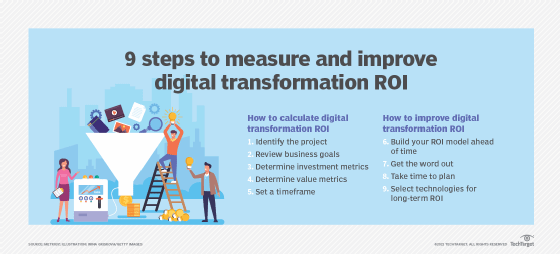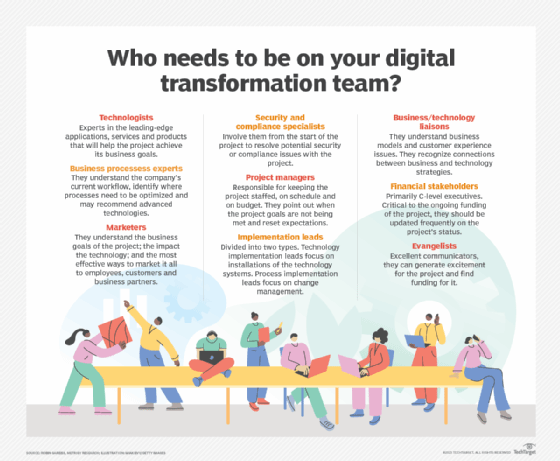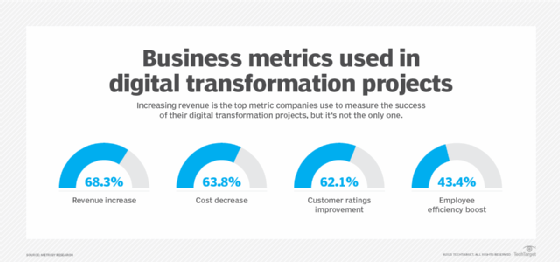6 tips to plan a digital transformation budget
Formulating budgets for digital transformation projects is fraught with complexities, expectations and unknowns that differentiate it from traditional IT and business planning.
Digital transformation projects can require significant investment in time and money before businesses realize cost savings, revenue growth or productivity improvements. Companies need to plan carefully and present convincing data to secure the necessary funding. But it's also important to recognize that formulating a digital transformation budget depends on different business processes than traditional IT and business budget planning.
Organizations are now using AI to hone their digital transformation strategy. Using AI, organizations can analyze large amounts of data to understand their unique business drivers and align their transformation efforts with market trends and customer demands. This ability to process large data sets and identify patterns leads to better decision-making as to where digital transformation budget dollars should be allocated.
Digital transformation budget considerations
Traditional budgeting is somewhat consistent year over year, with stakeholders requesting increases based on the previous year's operational and capital budgets. The budgeting process continues with back-and-forth discussions about the actual percentage increase or decrease until the budget is finalized.
In addition, traditional budgets typically cover technologies that keep the business operating and deliver the services employees need to do their jobs. Companies plan upgrades and replacements years in advance, employee counts generally stay fixed as a percentage of the total employee count and budgeting follows the same predictable model year after year with few unknowns.
This article is part of
What is digital transformation? Everything you need to know
Digital transformation is different in that every project is different. Expecting a return on investment puts different pressures on the budgeting process. Because most transformation projects are completely new, business leaders must factor in many variables. When budgeting for your digital transformation project, consider the following six tips.

1. Identify the project and participants
It's much easier to win budget allocation by identifying the most relevant project.
In larger companies, many projects could be competing for the same budget dollars. That's why it's also crucial to know the budget holders' areas of interest so you can map your projects to the right person and to all relevant pools of funding.
Having the right people on a project is critically important at this point. The team's capabilities could convince budget holders of the project's likelihood of success. Examine the track record of the key people on the digital transformation team as well as third-party partners who might assist with the project. Be sure to tout their credentials.
A top-tier digital transformation team also needs to be nurtured from the beginning. When possible, secure funding for in-person kickoff meetings and bonuses if the project is successful.

2. Identify the budget holders
There are various ways companies fund digital transformation projects. It's important that the people responsible for digital transformation identify all potential funding sources.
Some companies budget for the transformation projects and others don't. Those who budget might keep allocations centralized; others designate funds for transformation projects. But the amounts are distributed among several business units' budgets. Some organizations don't have a budget for their digital transformation strategy, but they do have a centralized or decentralized pool of discretionary spending. Even companies with transformation budgets might have discretionary spending that can be tapped to bolster digital projects.
3. Build the business case
The business case is perhaps the most important determinant of digital transformation success. Prior to pitching a project, build a case that shows the business benefits of the digital transformation project with success metrics and real-world improvements for employees and customers.
Building a successful business case can take three to six months for small organizations and six to 18 months for larger ones. Find out the spending figures and operational metrics from current spending so there's a basis for comparison. Then, cast a wide net for providers and service delivery to get approximate prices and set the budget.
The business case also should include a before-and-after view of what the transformation project will accomplish. In a client-facing initiative, for example, the company might be spending $25 per customer interaction because the only option is a voice call. A transformation project that digitizes the contact center will activate webchat, self-service knowledge bases and SMS. The digital transformation project's business benefits to the company include lower operational costs and more revenue via new predictive analytics tools to recommend products to customers in webchat or self-service.

4. Stay agile
Budget planning is always a best-guess effort. Until the project starts, it's difficult to predict every twist and turn on the digital transformation roadmap. Depending on the project, agility is important.
Smaller, single-app projects might only take three months to complete, in which case budget predictions likely will be more accurate. But larger projects might require some flexibility in the budget and the support staff. Labor rates might unexpectedly rise, new security rules might require additional software or new demands might emerge if leadership changes.
It's important to set expectations correctly -- namely, that project plans might change over time -- and to schedule regular updates with all stakeholders. This approach will protect the team's reputation come the next budget request.
5. Market the project's value
For digital transformation projects to be successful, professional marketers need to get the word out in creative, informative ways. Don't rely on IT to be responsible for user awareness of the new technology or processes. Building a digital transformation culture will spur adoption as well as inspire employees to use and improve new ways of working introduced by the project. Marketing experts can organize lunch-and-learns, create how-to content, and design logos and eye-catching materials that capture the interest of employees or improve the customer experience.
6. Measure success
Data helps secure funding. Track the success of your digital transformation initiative in metrics that matter. At the outset of a project, identify the baseline metrics and actual numbers. Then, track the change on preestablished intervals. Typical business metrics include the following:
- Revenue increase.
- Cost decrease.
- Customer ratings improvement.
- Employee efficiency boost.
Additional metrics include the following:
- Number of employees required to perform a task.
- Ability of the project to provide the business a competitive advantage.
- Employee retention.
- Technology downtime.

Measuring the success of a project on an ongoing basis will guard against a digital transformation failure. Not only does measuring success ensure team leaders are continuously revising processes to improve the metrics, but it also provides a track record of success for every future funding request. Over time, stakeholders will be more likely to fund projects proposed by those with a track record of documented success.
Editor's note: This article was updated in July 2024 to improve the reader experience.
Robin Gareiss is CEO and principal analyst at Metrigy, which conducts research and advises enterprises and technology providers.







